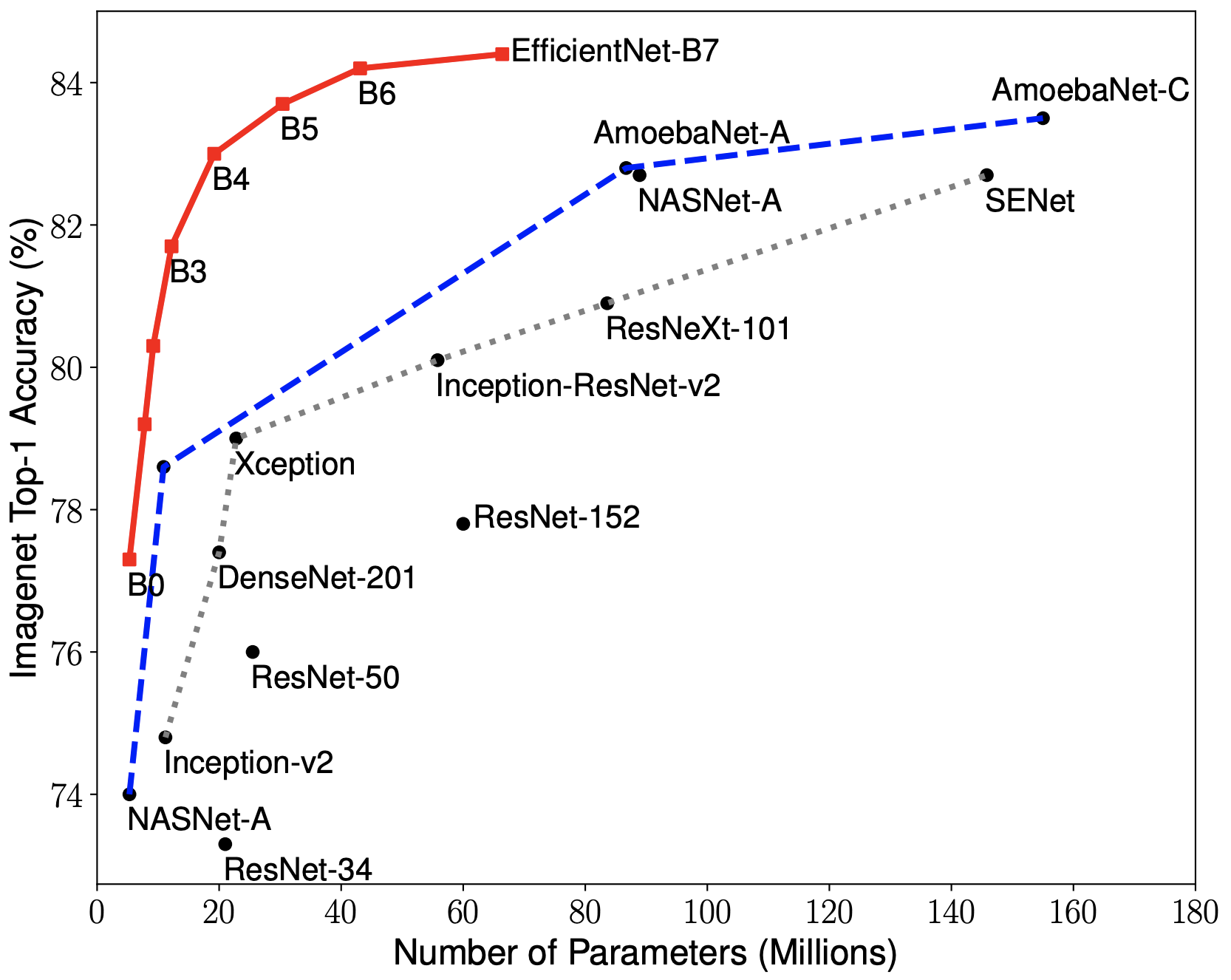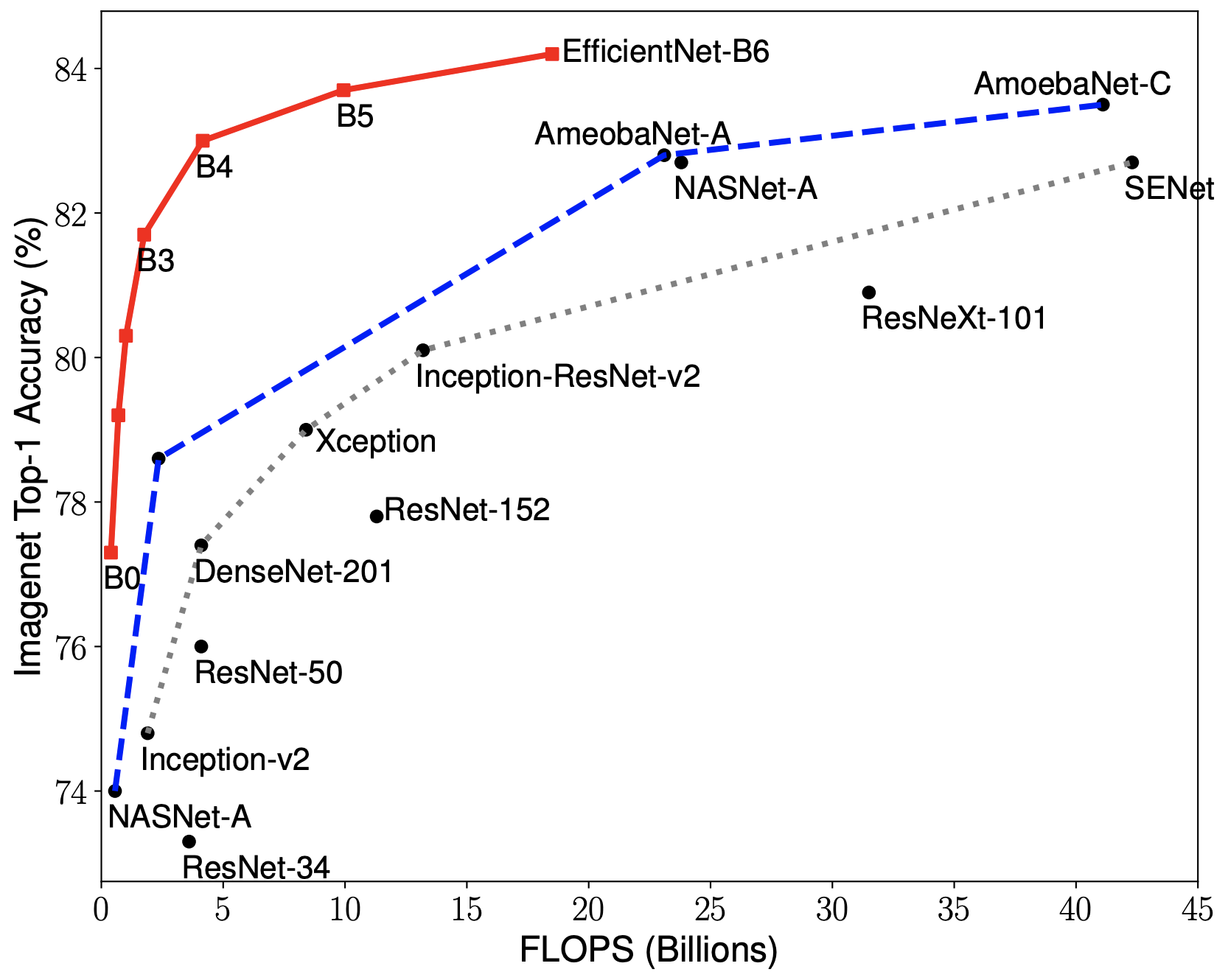https://github.com/qubvel/efficientnet
Implementation of EfficientNet model. Keras and TensorFlow Keras.
https://github.com/qubvel/efficientnet
classification deep-learning efficient efficientnet image-classification imagenet mobilenet nasnetmobile pretrained-models
Last synced: 7 months ago
JSON representation
Implementation of EfficientNet model. Keras and TensorFlow Keras.
- Host: GitHub
- URL: https://github.com/qubvel/efficientnet
- Owner: qubvel
- License: apache-2.0
- Created: 2019-05-30T20:21:09.000Z (over 6 years ago)
- Default Branch: master
- Last Pushed: 2024-01-24T14:27:34.000Z (almost 2 years ago)
- Last Synced: 2025-04-11T01:41:53.734Z (8 months ago)
- Topics: classification, deep-learning, efficient, efficientnet, image-classification, imagenet, mobilenet, nasnetmobile, pretrained-models
- Language: Python
- Homepage: https://arxiv.org/abs/1905.11946
- Size: 815 KB
- Stars: 2,082
- Watchers: 38
- Forks: 469
- Open Issues: 65
-
Metadata Files:
- Readme: README.md
- License: LICENSE
Awesome Lists containing this project
- awesome-python-machine-learning-resources - GitHub - 48% open · ⏱️ 16.07.2021): (Tensorflow实用程序)
- Awesome-Tensorflow2 - qubvel/efficientnet
README
# EfficientNet Keras (and TensorFlow Keras)
[](https://badge.fury.io/py/efficientnet) [](https://pepy.tech/project/efficientnet/month)
This repository contains a Keras (and TensorFlow Keras) reimplementation of **EfficientNet**, a lightweight convolutional neural network architecture achieving the [state-of-the-art accuracy with an order of magnitude fewer parameters and FLOPS](https://arxiv.org/abs/1905.11946), on both ImageNet and
five other commonly used transfer learning datasets.
The codebase is heavily inspired by the [TensorFlow implementation](https://github.com/tensorflow/tpu/tree/master/models/official/efficientnet).
## Important!
There was a huge library update on **24th of July 2019**. Now efficientnet works with both frameworks: `keras` and `tensorflow.keras`.
If you have models trained before that date, please use efficientnet of version 0.0.4 to load them. You can roll back using `pip install -U efficientnet==0.0.4` or `pip install -U git+https://github.com/qubvel/efficientnet/tree/v0.0.4`.
## Table of Contents
1. [About EfficientNet Models](#about-efficientnet-models)
2. [Examples](#examples)
3. [Models](#models)
4. [Installation](#installation)
5. [Frequently Asked Questions](#frequently-asked-questions)
6. [Acknowledgements](#acknowledgements)
## About EfficientNet Models
EfficientNets rely on AutoML and compound scaling to achieve superior performance without compromising resource efficiency. The [AutoML Mobile framework](https://ai.googleblog.com/2018/08/mnasnet-towards-automating-design-of.html) has helped develop a mobile-size baseline network, **EfficientNet-B0**, which is then improved by the compound scaling method to obtain EfficientNet-B1 to B7.


EfficientNets achieve state-of-the-art accuracy on ImageNet with an order of magnitude better efficiency:
* In high-accuracy regime, EfficientNet-B7 achieves the state-of-the-art 84.4% top-1 / 97.1% top-5 accuracy on ImageNet with 66M parameters and 37B FLOPS. At the same time, the model is 8.4x smaller and 6.1x faster on CPU inference than the former leader, [Gpipe](https://arxiv.org/abs/1811.06965).
* In middle-accuracy regime, EfficientNet-B1 is 7.6x smaller and 5.7x faster on CPU inference than [ResNet-152](https://arxiv.org/abs/1512.03385), with similar ImageNet accuracy.
* Compared to the widely used [ResNet-50](https://arxiv.org/abs/1512.03385), EfficientNet-B4 improves the top-1 accuracy from 76.3% of ResNet-50 to 82.6% (+6.3%), under similar FLOPS constraints.
## Examples
* *Initializing the model*:
```python
# models can be build with Keras or Tensorflow frameworks
# use keras and tfkeras modules respectively
# efficientnet.keras / efficientnet.tfkeras
import efficientnet.keras as efn
model = efn.EfficientNetB0(weights='imagenet') # or weights='noisy-student'
```
* *Loading the pre-trained weights*:
```python
# model use some custom objects, so before loading saved model
# import module your network was build with
# e.g. import efficientnet.keras / import efficientnet.tfkeras
import efficientnet.tfkeras
from tensorflow.keras.models import load_model
model = load_model('path/to/model.h5')
```
See the complete example of loading the model and making an inference in the Jupyter notebook [here](https://github.com/qubvel/efficientnet/blob/master/examples/inference_example.ipynb).
## Models
The performance of each model variant using the pre-trained weights converted from checkpoints provided by the authors is as follows:
| Architecture | @top1* Imagenet| @top1* Noisy-Student|
| -------------- | :----: |:---:|
| EfficientNetB0 | 0.772 |0.788|
| EfficientNetB1 | 0.791 |0.815|
| EfficientNetB2 | 0.802 |0.824|
| EfficientNetB3 | 0.816 |0.841|
| EfficientNetB4 | 0.830 |0.853|
| EfficientNetB5 | 0.837 |0.861|
| EfficientNetB6 | 0.841 |0.864|
| EfficientNetB7 | 0.844 |0.869|
**\*** - topK accuracy score for converted models (imagenet `val` set)
## Installation
### Requirements
* `Keras >= 2.2.0` / `TensorFlow >= 1.12.0`
* `keras_applications >= 1.0.7`
* `scikit-image`
### Installing from the source
```bash
$ pip install -U git+https://github.com/qubvel/efficientnet
```
### Installing from PyPI
PyPI stable release
```bash
$ pip install -U efficientnet
```
PyPI latest release (with keras and tf.keras support)
```bash
$ pip install -U --pre efficientnet
```
## Frequently Asked Questions
* **How can I convert the original TensorFlow checkpoints to Keras HDF5?**
Pick the target directory (like `dist`) and run the [converter script](./scripts) from the repo directory as follows:
```bash
$ ./scripts/convert_efficientnet.sh --target_dir dist
```
You can also optionally create the virtual environment with all the dependencies installed by adding `--make_venv=true` and operate in a self-destructing temporary location instead of the target directory by setting `--tmp_working_dir=true`.
## Acknowledgements
I would like to thanks community members who actively contribute to this repository:
1) Sasha Illarionov ([@sdll](https://github.com/sdll)) for preparing automated script for weights conversion
2) Björn Barz ([@Callidior](https://github.com/Callidior)) for model code adaptation for keras and tensorflow.keras frameworks